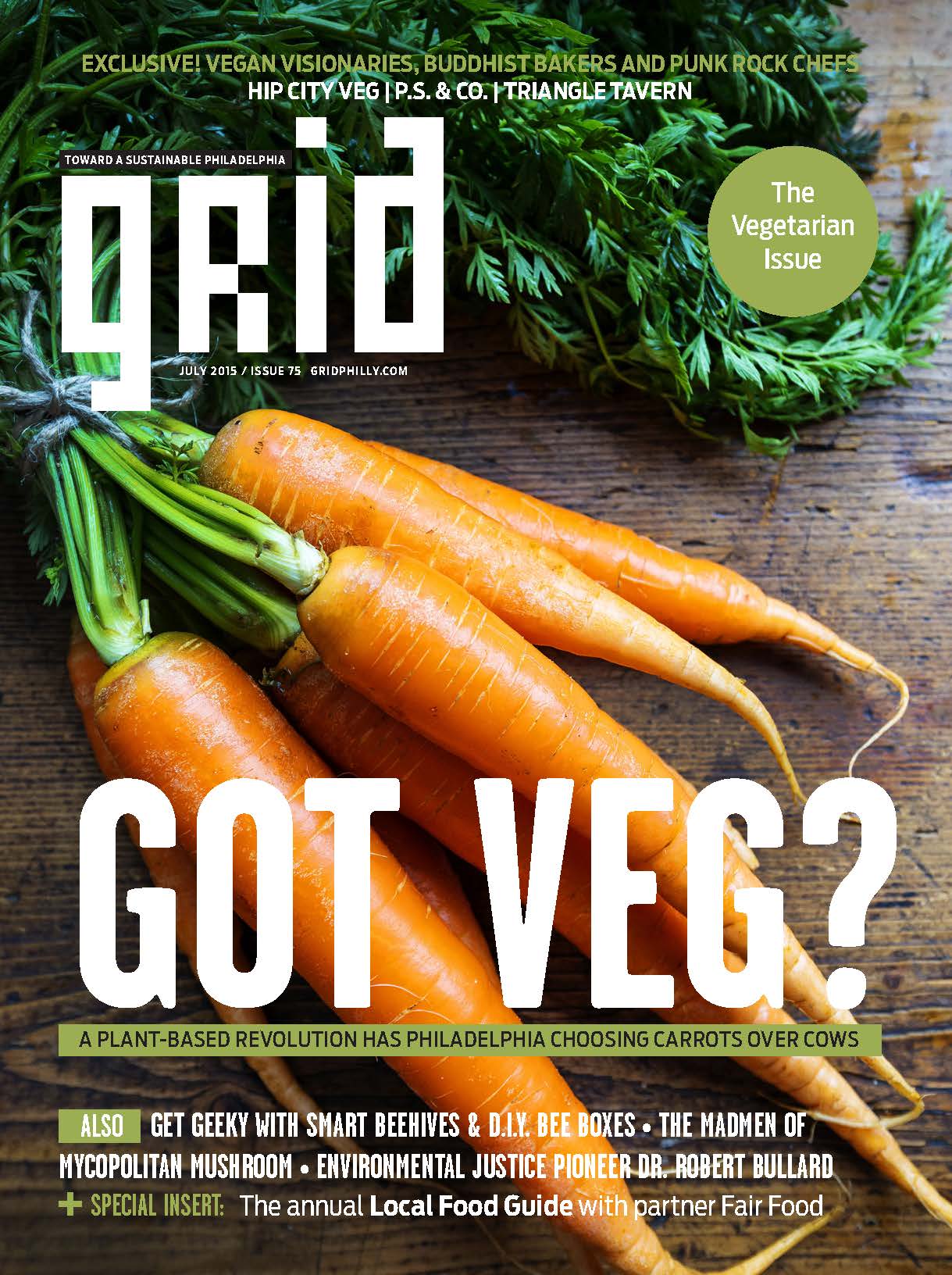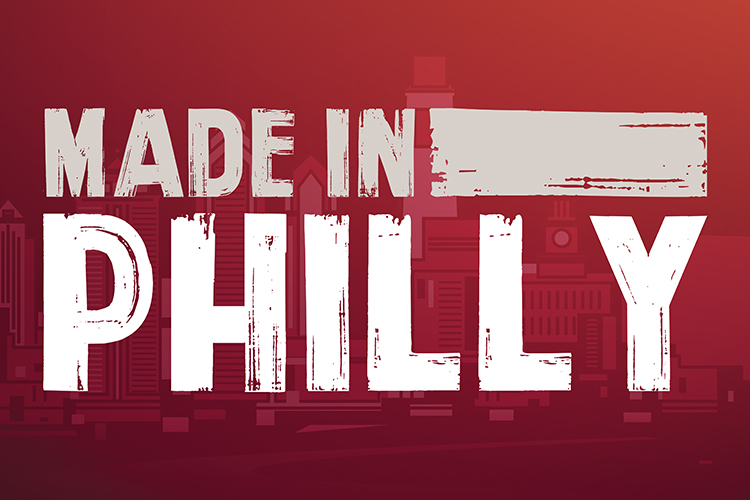by Heather Shayne Blakeslee
data-animation-override>
“Starting a revolution at your kitchen table while you’re joyfully eating delicious food and drinking a locally made beer with friends is something of a tradition in Philadelphia. Let’s keep it going. ”
Philadelphia is a deep green city, and the world knows it. But while we’ve been receiving international accolades for greening our streets and kudos for making our buildings more efficient, we’ve been simultaneously earning another reputation: as a top-tier city for vegetarian food. Recognizing this trend, the Philadelphia Convention & Visitors Bureau has launched a new section of its website dedicated to navigating our city as a diet-conscious visitor. Marketing Philadelphia to people around the world—who statistically are much less likely to live a meat-centric life than Americans—is a smart move that will boost the city’s veggie economy and reputation… not that it needs any help right now. The revolution is underway.
The Humane League’s annual Veg Dining Guide has over 280 restaurant entries this year, and even that extensive list is incomplete. The lines are out the door at lunchtime at Hip City Veg, and every loved neighborhood gastropub has a satisfying menu for people who abstain from meat. The Phillies stadium only recently relinquished its number one spot for veg-friendliness as ranked by the advocacy group PETA (we’re still number two, second to last year’s world champions, the San Francisco Giants). Even our top Zagat-rated restaurant in town offers solely plant-based cuisine: the vegan dreamland at Vedge can require a
several-week wait for reservations. Two other restaurants in the top five, Vernick (rated number three) and Zahav (rated number five) are easy for vegetarians to order from as well. Want a local neighboorhood coffeehouse? Grindcore House in South Philadelphia has you covered. Vegan pizza and wings? Head to Blackbird Pizzeria just north of South Street. These establishments are proof that quality and convenience are part of being a vegetarian in Philadelphia.
We’re a city that loves good food. The fact that we have more and more choices when it comes to plant-based cooking can’t come soon enough for our health, the welfare of farm workers and animals, and the fate of our planet.
Can we have a healthier life?
In the United States, only 3.1 percent of people count themselves vegetarian or vegan, so most of us are eating meat.
In fact, we eat staggering amounts of it. According to United Nations data Americans eat an average of 275 pounds of meat per year. We’re eating too much of everything, a habit that has resulted in two-thirds of American adults being overweight and often obese. In Philadelphia, the statistics are even more grim: we’re among America’s fattest cities. Obesity, only recently classified as a disease in and of itself, raises risks for many other diseases, including the number-one killer in the United States: heart disease.
A plant-based diet can be part of reversing those statistics. One research team found their participants, who adhered to a mostly vegetarian diet—70 percent of food coming from plant sources—were 20 percent less likely to die from heart disease compared to those who only received 45 percent of their food from plant-based sources. Another study shows that vegetarians live an average of ten years longer, and another that cancer risk could be reduced by up to 40 percent. Even if your primary motivation is just to drop a few pounds, consider that the average vegan weighs 30 fewer pounds than the average omnivore.
It’s been difficult for researchers to parse out direct correlations when it comes to a vegetarian diet because vegetarians in developed nations tend to be more affluent and educated than the general population, and also tend to live a healthier lifestyle: they drink less, smoke less and exercise more.
Any changes in our diets—whatever the reasons we make them—will come slowly, and many people will continue to erroneously think that they must eat meat to maintain a healthy diet. It’s one of the biases of our meat-centric culture, which are many. Most of us grew up with spaghetti and meatballs—it’s comfort food. And almost all of our meat and dairy comes from ruthlessly efficient factory farms and processing plants that makes our food cheap, so eating meat instead of other foods doesn’t affect our pocketbooks all that much either. Additionally, our food system, and the animals we depend on for our food specifically, are far removed from our lives as they are being raised, used and slaughtered. That’s by design, of course, and lack of transparency comes at a great cost, specifically to our values.
So, where does our food come from?
One of those values is how we treat animals. A family dog would never be allowed to suffer the conditions of a factory farm, and yet very similar animals languish there every day. The exploited heifer isn’t on our mind when we grab a yogurt off the grocery shelf. What is in front of us is that steady stream of perfectly packaged, heavily marketed, sanitized food products.
Despite how unpleasant it is to look at the sources of our food, and how easy it has been made for us to never see beyond the shelves of the supermarket, it’s incredibly important that we do.
Our diet requires the slaughter of over 9 billion animals a year in the United States. Dairy cows or laying hens are not part of these numbers. Well over 8 billion of those animals are chickens that are exempt from the three federal animal welfare laws that regulate the transport and slaughter of farm animals. Regulation of what happens on farms is largely left up to states, which are more likely to care about enticing and appeasing big businesses than regulating their operations.
Common practices on the modern industrial farm include unanaesthetized physical alterations such as castration, tail docking, dehorning, branding and beaking (cutting the beaks off of live birds). Multiple animals are kept in small cages or in severely overcrowded conditions without fresh air or sunlight, where many are hobbled by the hard concrete or wire cage bottoms. They are burned and poisoned by the build-up of their own feces. Many do not have space to turn around for their entire lives, much less to engage in natural behaviors like running, rooting, dust-bathing and raising their young. They are unlikely to receive individualized veterinary care even if they are suffering greatly, and the living animals are forced to step over and sleep with the dead. Many animals spend their entire life in unnatural cycles of continual forced pregnancies, especially dairy cows and pigs. Steroids and growth hormones bulk up the bodies of these animals faster than they would grow naturally, and there is widespread use of prophylactic antibiotics to prevent the many diseases that prevail in these horrific conditions. There is increasing evidence that these chemicals end up in our food and water supply.
Just as we tend to forget the faraway people who manufacture our clothing, we largely ignore the dangerous conditions endured by farm and meat processing workers, One of the efficiencies of the modern farm is how few workers it needs, but it does need some, and they perform dehumanizing work in dystopian conditions.
If you have had trouble maintaining a vegetarian diet, think about the animals. While most people become vegetarians for health reasons, studies show that those who adopt a plant-based diet are more likely to make a permanent change if they’re motivated by empathy for animals.
Meat: A serious threat to the environment
The meat industry relies upon the same thing that every other industry relies upon: fossil fuels. The production of fertilizers, necessary for the production of crops to feed livestock, is a fossil fuel-intensive
industry.
The case is the same for pesticides, which are necessary to maintain the vast farms that are used to grow the grains that are fed to animals (whether their bodies are designed to eat them or not). The liberal use of pesticides harms our waters. Toxic runoff from pesticides and animal manure concentrated in the Midwest food cradle have created a low oxygen dead zone the size of Connecticut in the Gulf of Mexico.
Factory-farmed meat is also accelerating global warming. According to a 2006 report from the United Nations, livestock accounts for 18 percent of all greenhouse gases—more than all transportation.
Energy isn’t the only resource that meat demands. The California drought has taught us all that a pound of hamburger takes almost 1,800 gallons of water to produce.
The most compelling environmental arguments are perhaps mathematical ones. The world’s population grows rapidly every day. The earth is now home to over 7 billion people. Worldwide, we now slaughter 56 billion animals annually, and, according the U.N., that number will double by 2050, when the human population will reach close to 10 billion people. That’s 122 billion human and farm animal lives counting on our already compromised ecosystem.
Even if we continue our cruel farming practices of crowding animals, they have to go somewhere. These same animals also need to eat, which will require more land for farming grains, and that will come at the expense of other ecosystems. Beef production has been the number-one cause of deforestation in the Amazon, and it, as well as other biologically diverse yet vulnerable lands, will be devastated by the growth of the meat industry.
While global demand for meat is on the rise, it is encouraging that the United States may have reached “peak meat” in 2004. Consumption has been down slightly over the ensuing years, a trend that may continue as more light shines on the health, animal welfare and environmental impacts of the meat industry.
Your part in making a change
None of the facts about factory farming in this article are likely to be disputed by anyone, and many of us are familiar with much of this information already, and yet it’s unlikely we will see the 97 percent of us who eat meat suddenly stop. However, there is still much we can do if we are not ready or willing to abstain from meat.
Grid has three proposals that would help overthrow the current system. Given our access to good food choices in Philadelphia, these recommendations are very easy, will save people money, offer considerable health benefits, and help us collectively in our quest to live in a sustainable Philadelphia and a humane world.
First, make a personal commitment not to waste food, particularly if an animal had to suffer or die in order for it to reach your plate. The USDA reports that we are losing, depending on the product, four to 12 percent of animal-based food at the retail level from spoilage, and consumers are responsible for wasting an astounding average of 24.4 percent more of animal products at home. This waste comes from our inattention and poor planning—buying too much and putting too much on our plates at meal time. Let’s start with a commitment to being more mindful.
Second, we’d like to raise the bar on the Humane League’s “Meatless Monday” campaign. Instead, pick one day a week when you do eat meat. Eating meat just once a week, or about 14 percent of the time, would also mean that we fall in line with new dietary standards expected from the FDA later this year, which will likely advise us to eat a more plant-based diet. The recommendations cite not just our personal health, but the health of the planet as a reason to collectively evolve our food choices.
Finally, if you are going to continue to consume animal products—and most of us will—make the effort to know where the food comes from. Patronize farms, markets and businesses that align with your values. With our values.
Eating a plant-based diet, even if it’s a mostly plant-based, is easy in Philadelphia. It may even be fun, as you have meals and conversations that help you reflect on your intentions about living in the world.
Starting a revolution at your kitchen table while you’re joyfully eating delicious food and drinking a locally made beer with friends is something of a tradition in Philadelphia. Let’s keep it going.







